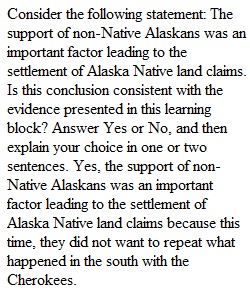


Q Overview: The short response activities in the webtext throughout this course are designed to show your understanding of key concepts as you engage with course content. Prompt: During the eighth week of the course, you will respond to several questions in the webtext as you complete each learning block. At the end of Module Eight, you will review your answers to these questions and ensure that you have responded to each question. It is important that you answer each question; otherwise, the words “[no response]” will appear in brackets when you submit the assignment. The questions and their original locations in the webtext are listed in this table in case you want to refer back to the reading as you edit, but you can edit your responses to all the questions directly in Module Eight: Thinking About History, continued, learning block 8-4 (page 3) in the webtext, before exporting to Word for submission to your instructor in your learning environment. Module Eight: Thinking About History, continued, Learning Block 8-1 (page 1): Question 1: Consider the following statement: The support of non-Native Alaskans was an important factor leading to the settlement of Alaska Native land claims. Is this conclusion consistent with the evidence presented in this learning block? Answer Yes or No, and then explain your choice in one or two sentences. Question 2: Consider the following statement: ANCSA was a fair settlement for Alaska Natives. Is this conclusion consistent with the evidence presented in this learning block? Answer Yes or No, and then explain your choice in one or two sentences. Question 3: Consider the following statement: ANCSA led to economic benefits for white Alaskans as well as for Natives. Is this conclusion consistent with the evidence presented in this learning block? Answer Yes or No, and then explain your choice in one or two sentences. Module Eight: Thinking About History, continued, Learning Block 8-2 (page 2): Question 4: For an American literature course: What skills from this course would you use to develop a brief essay on the significance of Walt Whitman’s “When Lilacs Last in the Dooryard Bloom’d,” a poem written in the summer of 1865? Question 5: For a sociology course: What skills from this course would you use to produce an annotated bibliography for your course research project? Question 6: For a business course: What skills from this course would you use to decide between two different investment proposals? Module Eight: Thinking About History, continued, Learning Block 8-3 (page 2): Question 7: How can history serve as a lens for the rest of the academic program you will pursue at SNHU? Has this course changed the way you think about what you want to study? Why or why not? Module Eight: Thinking About History, continued, Learning Block 8-4 (page 2): Question 8: What did you learn about one of these topics or historical events that was new or surprising to you? Explain in at least two to three sentences. Question 9: In one paragraph, explain which parts of your historical investigation and analysis were most interesting to you. Which parts were less interesting? Rubric Guidelines for Submission: Your responses to Questions 1, 2, and 3 should be 1–2 sentences in length. Your responses to Questions 4, 5, 6, 7, and 8 should be 2– 3 sentences in length. Your response to Question 9 should be 1 paragraph in length. Follow the instructions at the bottom of Module Eight: Thinking About History, continued, learning block 8-4 (page 3), to download your work and submit it to your instructor as a single Microsoft Word document uploaded to your learning environment. Refer to the Submitting Webtext Assignments Guide for assistance on downloading, saving, and submitting this assignment. Critical Elements Exemplary Proficient Needs Improvement Not Evident Value Engagement Written responses completely Written responses completely Written responses address the No written responses provided 30 address all short answer address the majority of short minority of short answer to address any short answer prompts answer prompts prompts prompts (100%) (85%) (55%) (0%) Relevance Written responses directly Written responses are topically Written responses do not 20 address short answer prompts, related to short answer address topics identified in drawing from presented course prompts, but responses do not short answer prompts concepts and terminology consistently draw from (0%) (100%) presented course concepts and terminology (85%) Accuracy Written responses are Written responses contain Written responses contain No written responses are 20 completely accurate minor errors but are mostly major errors provided (100%) accurate (55%) (0%) (85%) Critical Thinking Written responses demonstrate Written responses demonstrate Written responses do not 20 understanding of course understanding of course reflect original ideas and content through inclusion of content through reiteration of examples original ideas and examples provided materials, but do not (0%) (100%) consistently include original ideas and examples (85%) Articulation of Written responses are captured Written responses are captured No written responses are 10 Response in complete sentences without in incomplete sentences or captured in complete sentences grammatical errors impacting include numerous grammatical (0%) legibility and the clarity of errors that negatively impact response legibility and the clarity of (100%) response (85%) Total 100%
View Related Questions